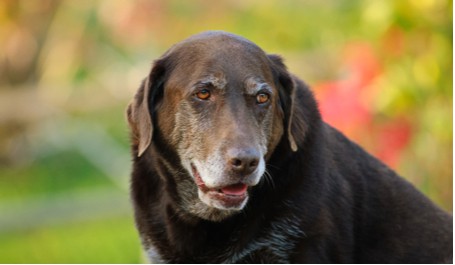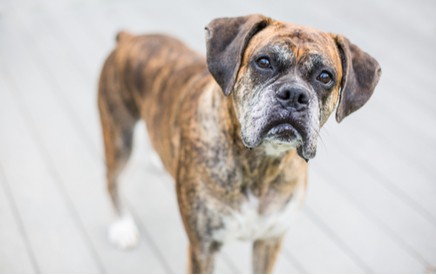A 15 year old dog breed of average weight and size, is equivalent in age to a 95 year old person.
A 15 year old giant dog breed weighing over 100lbs, would be equivalent to a 114 years old person.
That age with a small dog breed, weighing 20lbs or less, would be equivalent to a 76 year old person.
It doesn’t matter whether you have had your dog from a pup, or you rescued them as a fully-grown dog. Either way, if your dog is getting older, you may be curious to know how old they are compared to a human being.
If a dog reaches the age of 15, it is well into its senior years. This holds true for a dog’s life and how it relates to that of a human. It helps to understand what to expect from a dog that is 15 years old, too.
I’ve done plenty of research on the subject, bringing you the best distilled information on the age and condition of a 15-year-old dog here, so there’s no need to look anywhere else.
A dog aged between 13 and 15 is considered elderly
The older a person gets, the more likely it is they could suffer from health issues. They’ll slow down a little too.
The same applies to dogs. Understanding this and knowing what to expect is a good thing, as it gives you the confidence to properly care for and continue to love your pooch.
A larger 15-year-old dog is older compared to a small dog of the same age
Does that sound odd? It’s not – it is well known that larger breeds age faster than smaller ones.
According to the American Kennel Club (AKC), a giant breed of dog weighing over 100lbs would be the equivalent of 114 human years if they reached 15 years of age. Humans celebrate if they hit the magic 100 years, so you can see how old a giant breed is if it reaches that milestone.
Conversely, a small breed weighing just 20lbs or under would be equal to a 76-year-old human—quite a difference.
The commonly touted one dog year to seven human years ratio is incorrect

You may have realized this by now. It’s unclear where this idea came from, but you might have heard of it since getting a dog. Maybe you’ve worked out your own dog’s age according to that ‘rule.’
However, dogs grow way faster than humans do to start with. Most dogs are considered fully grown and adult in age by the time they hit the grand age of two. If you used the 1:7 ratio there, you would conclude that humans are adults by the age of 14.
Ahem.
Yes, I doubt you agree with that. I certainly don’t!
The AKC has determined that the first year of a dog’s life equals about 15 years of a human’s life. The exception is for giant breeds that match the growth of a 12-year-old human instead.
In year two, they are the equivalent of a human in their mid-twenties. Only after that does the growth slow down, adding on around four human years for every year of a dog’s life. That is the best guide to figuring out where your own dog sits on the age scale compared to humans.
The easiest way to work out age is by using a dog age calculator
The rule of thumb you may have used until now has been debunked. So, working out the age of a 15-year-old dog isn’t as easy as you thought, especially since breed can change things too.
Looking for an online calculator means you only need to type in or select the age and size of your dog to get your answer.
Some dog age calculators let you select the breed
This type of calculator tends to be more accurate. It uses specific data for each breed, so you are going to get a better idea of how old your dog is if they have reached 15 years.
It is also easier to get the answer to how old your dog is compared to a human by punching in their age and selecting their breed, rather than trying to work it out alone.
No calculator can consider all the variables
Humans have different life expectancies depending on numerous factors. The same applies to dogs. Here are some examples of how this works. Older dogs might:
- Live in different countries
- Experience different climates
- Be used to more exercise or less than its counterparts elsewhere in the world
- Have unique genes handed down from their parents
- Be exposed to the biological weaknesses in their breed
Even the more accurate calculators can only provide a ballpark idea of the equivalent human age of your dog. It does give you a good idea of the life stage your pet is going through, however.
Changes to a dog’s routine are not a good idea at this age
Younger dogs are more adaptable than older ones. They can learn new things and adjust more speedily when changes occur.
If your dog reaches 15 years of age, try to keep their daily routine as normal as possible. If your dog goes into kennels or stays with a friend when you go on vacation, stick to that same routine.
Don’t try somewhere new as it will likely be unsettling and difficult for your pet to manage.
Some changes might be necessary though depending on its health
Just as humans are prone to certain ailments as the years roll by, the same applies to dogs. A 15-year-old pooch might experience the following:
- Dental decay and more tartar
- One or more teeth may need to be removed
- Arthritis becomes more common
- Other age-related issues may be experienced according to breed
- Hearing and vision may decrease
- Incontinence may occur
You may need to change their food to make it easier to eat
A good example would be to swap from dried kibble to soft food if your dog has problems with their teeth. I recall an older Jack Russell in our family who had lost almost all its teeth by this age. She could manage tinned food and gave up anything that was harder to bite or chew.
It’s not just down to their teeth though. A good diet is essential throughout your dog’s life. Many dog food manufacturers offer different formulas for puppies, adult dogs, and senior dogs. So, you might need to switch from one to another over time.
If you do decide it would be a good idea to switch foods for your senior dog, do so gradually. This reduces the chances of any stomach issues while you’re changing over.
Comfort is more important in old age
Arthritis is a common issue in many dogs. If your dog finds it difficult to get in and out of their bed, you might consider buying a different dog bed.
Our Bichon is still quite young at five years old, and she likes her bed to have raised sides and a snuggly back. She likes to snuggle right into it, often sleeping on her back with her back legs up on one side and her head on the other.
However, if she was older, I think she might have issues sleeping like that. Older dogs often fare better on flatter beds made from memory foam. They mold to their bodies and make it a lot more comfortable for them to rest their joints on them.
Another common issue many dogs experience in old age is incontinence. It is possible to purchase waterproof beds that are easily washable with removable covers if you experience this issue with your 15-year-old pooch.
Make sure your dog has at least an annual check-up
Some vets recommend six-monthly check-ups at this age. Their annual jabs should still be given, of course, but a vet might recommend other checks depending on your pet’s health, breed, and other factors.
Be alert for any changes in their behavior

You know your dog best. You know their character, temperament and usual routine. Watch for any of these to change. If they do, seek advice from your vet.
Some changes might be more obvious than others. They may find it harder to:
- Eat their normal food
- Do the usual dog walk without tiring
- Make it outside to go to the toilet
- Sleep properly, perhaps because they are uncomfortable
The sooner you seek advice from your veterinarian for any such changes, the sooner they will be able to determine whether there are any issues. It may simply be that your dog is getting older and cannot do everything they once could.
Even when your dog starts to exhibit some of the signs of aging, it doesn’t mean their life could become less enjoyable. Many conditions can be treated with daily medications helping to manage pain, discomfort, and other issues.
Just as a human will age and perhaps lives a little differently to reflect that, so too does a dog. Your walks with your beloved dog are likely to be shorter and slower than they once were. But you can still enjoy them together in a different way.
Perhaps stop by that bench you pass by every morning on your daily walk. Sit for a while, let your dog rest, and enjoy spending those moments together.
Maybe they’ll be happy to lie next to you as you sit on the couch at home or snooze in the sun in the yard. Taking good care of your dog is an important and responsible role throughout its life. That doesn’t stop as they age.

Sources:
https://www.pedigree.com/dog-care/dog-age-calculator
https://www.akc.org/expert-advice/health/how-to-calculate-dog-years-to-human-years/
http://www.age-converter.com/dog-age-calculator.html
https://www.actijoy.com/blogs/news/how-old-is-your-dog-in-human-years
https://vcahospitals.com/know-your-pet/how-old-is-old-comparing-dog-age-to-human-age
http://www.vetstreet.com/dogs/your-senior-dog-what-to-expect-at-13-to-15-years
https://www.almanac.com/content/dog-age-chart-dog-years-human-years
https://pets.webmd.com/dogs/how-to-calculate-your-dogs-age
https://www.businessinsider.com.au/is-a-dog-year-equal-to-7-human-years-2014-10

